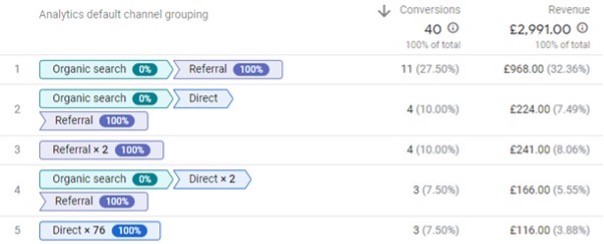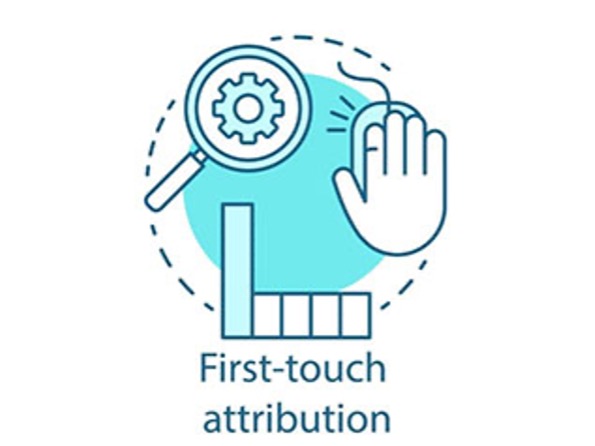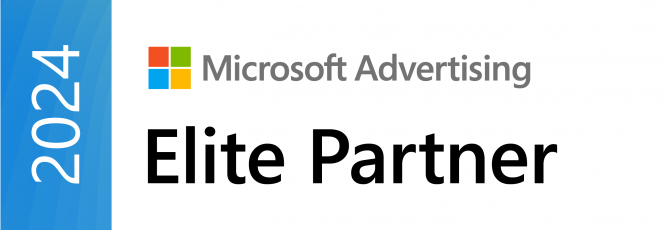
Do you ever feel like you need more insight into the various touchpoints throughout your customer’s purchasing journey and how they impact conversions?
With so many channels available to distribute ads and connect with customers, it’s becoming increasingly difficult to pinpoint those driving the most sales.
In today’s landscape, customers usually engage with your brand around 7 times before deciding to make a purchase.
Multiple visits mean they may have visited your social media page, website, or landing page – they may have also viewed a retargeting ad, signed up for your newsletter and read your emails, and more – all within several days of their eventual purchase.
With this being the case, it’s understandably difficult to decide where to assign credit for the conversion. Was it a search ad that generated the sale, a post on social media – or was it a combination of multiple channels, or just a few in particular?
The arduous decision-making process is why Attribution Modelling is essential. This post will explain when and how to change your attribution model in Google Analytics.
By doing so, you’ll be able to properly assign credit where it’s due and build an accurate picture of where, why and how your conversions are being generated. So keep reading for all the details.
First, let’s start with the basics. Attribution models are rule sets that allow you to specify how much credit is assigned to each ad interaction throughout your customer’s conversion path.
In other words, they help you understand your customer’s steps before converting. This allows for better insights that can be used to optimise your marketing activities and generate even greater campaign success.

You can see how much credit each ad interaction receives with Google Analytics default attribution models. You also can change the attribution settings to suit your needs better.
This extra level of control allows businesses to improve their bidding by better understanding their ads and how they perform.
There are several attribution models that you can use in Google Analytics, and each has its strengths and weaknesses. For example, you can choose from the following:

This model attributes all of the credit for a conversion to the final ad that was clicked before a conversion took place. It is simple to understand and easy to set up; however - it doesn't give any credit to the ads that may have been clicked earlier in your customer's journey.

Time decay is factored in with this last click attribution model. So if someone clicks on your ad today and buys something tomorrow, that purchase is attributed to your ad. However, if they clicked on your ad last week and bought something today, only a portion of that purchase is attributed to your ad. The exact percentage depends on the lookback window you've set in Google Analytics. By default, it's set to 30 days, but you can change it to anywhere from 1-90 days.

As you might expect, this model attributes 100% of the credit for a conversion to the first touchpoint. So, if a user clicks on an ad, then goes to your website and converts, the entire conversion is attributed to the initial ad click.

This model attributes equal credit to all touchpoints within a certain lookback window leading up to a conversion. So, if a user clicks on an ad, then goes to your website and converts, each touchpoint would be attributed with 1/3 of the credit for the conversion. This model is not time-decaying, meaning it places equal importance on all touchpoints within the lookback window regardless of when they occurred.

The time-decay model attributes more credit to ads that are clicked closer to the time of conversion. This model is more complex than the others but provides a more accurate representation of how each ad contributes to a sale.

Under this model, 40% of the credit is given to both the first and last interactions, respectively, with the remaining 20% being divided evenly between the midway interactions.
This attribution model gives credit to the last point of contact that was NOT from a direct visit to a website. This version is the default attribution model used by Google, so if you haven't changed it, this is the modelyou'll currently use on your Google Analytics account.
In a nutshell, the data-driven attribution model uses machine learning to analyse your account's data to determine which channels are driving conversions. It considers click-through rates, time to conversion, and other factors to produce insights that best explain how each touchpoint performs. The great thing about this model is that it's continuously improving as more data is collected.
This attribution model relies on a set of pre-determined rules to assign credit for conversions. In summary, it looks at the user's journey leading up to the conversion and then awards credit based on the first and last touchpoints. However, rules-based automation does not take historical data into account.
The type of attribution model you choose depends on your business, how closely each attribution model’s data aligns with your marketing activity, and your unique end goals.
If you have enough data, we recommend you use data-driven attribution models, as they can provide the most insight into your ad performance and paint the clearest picture for success.
If you do not have enough data, then rules-based automation is often the next best attribution model.
Google Analytics makes it easy to compare the different types of attribution models; go to “Conversions” > “Attribution” > “Model Comparison Tool.” You can select up to three attribution models and compare their results.
However, the key here is to play around with the options available to find the one that suits you and your business the most – what works for some may not work for others.
Like most people, you probably use the default attribution settings in Google Analytics. But did you know that you can also create a custom attribution model?
It’s easy to do. Here’s how:
Once you’ve created your attribution rules, test them and see how they impact your data. If you’re unhappy with the results, you can always adjust or delete your attribution settings.
Like most people, you probably use the default attribution settings in Google Analytics. But did you know that you can also create a custom attribution model?
It’s easy to do. Here’s how:
Once you’ve created your attribution rules, test them and see how they impact your data. If you’re unhappy with the results, you can always adjust or delete your attribution settings.
Follow these steps to help you set up the Google Analytics attribution model feature:
Step 1: Log in to your Analytics account, then select Attribution from the navigation on the left.

Step 2: Open your campaign, then select the Keywords tab to view the reporting table.
Step 3: Now, click Columns, Custom Conversions and then Google Analytics.
Step 4: From here, click Create to build a new column. Now you can choose an attribution model, and your chosen model will filter your campaign data.
Step 5: Next, you need to select your metric from the list of options provided. The metric will be the attribution model for contextualising your data.
Step 6: Click Save to save your change and continue using the chosen attribution model.
Now you know how to set up the Google Analytics attribution model feature, it’s also important to understand how to change this from the default.

To change the attribution model for an existing conversion action, you need to:
Step 1: Log in to your Google Ads Account.
Step 2: Click the tools icon in the upper right corner, then, under Measurement, select Conversions.
Step 3: Select the conversion you want to edit by clicking on the conversion name in the table.
Step 4: Next, click Edit settings.
Step 5: Click on Attribution Model, then select an attribution model from the drop-down menu.
Step 6: Finally, click Save and then Finished.
When it comes to attribution models, there’s no one-size-fits-all solution. The best attribution model for your business will depend on various factors, including your marketing goals, industry, and target audience.
If you’re not happy with the results you’re seeing, a different model might give you a more accurate picture. Additionally, a new attribution model can help you understand the customer’s journey and how each touchpoint contributes to the overall sale.
With that being said, how do you know when it’s time to change your attribution model?
Here are three reasons to switch things up:
If you're seeing a decrease in customer conversion rates, it may be time to make adjustments. Alternatively, if you notice that certain channels are underperforming, it might be time to give them less weight in your attribution model.
Has your customer journey changed? If so, your attribution model may need to change as well. For example, suppose you've started selling products online, and customers are now interacting with your brand across multiple channels (e.g., web, mobile, social). In that case, you'll need an attribution model to track those interactions.
It's generally a good idea to switch to a more sophisticated attribution model when you have collected enough data to support it. Surplus data typically happens after you've been tracking conversions for at least a few months. Once you have substantial data, you can experiment with different attribution models to see which provides the most accurate picture of how your marketing efforts are working together to drive conversions.
For PPC managers taking care of multiple accounts and monitoring a wide range of PPC activity, it can be tiresome to keep on top of it all. Contact the team at Diginius today to find out how we can help you manage your accounts and take them to the next level.







© 2024 Diginius Ltd. All rights reserved.

Chester Yang is the Microsoft Program Manager at Diginius with a background in economics and quantitative research.
At Diginius, Chester focuses on nurturing partnerships with PPC agencies and integrating marketing and sales solutions.